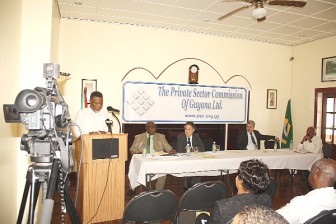The level of bilateral trade between Guyana and Brazil is below expectations, even after the opening of the Takutu Bridge, which had been expected to stimulate growth.
This was the assessment presented by President of the Guyana Manufacturing and Services Association (GMSA) Clinton Williams yesterday, when he addressed a gathering at Duke Lodge in Kingston, where the Guyana/Brazil private sector integration project was formally launched.

According to Williams, who gave a brief background to Brazil’s rise as one of the economic giants of the world, it is logical that Guyana stands to gain from strengthening its economic partnership with the neighbouring country.
He said the reality today is that despite a number of major trade and infrastructural investment initiatives, the intended benefits of cross-border trade and investment activities between the two countries are “still way below expectation after 10 years.”
Williams listed the Partial Scope Agreement, which was initiated in 2001, as well as the multi-million dollar Takutu Bridge, as vehicles which should have been forging the advancement of trade between the two nations. He said the GMSA and the private sector as a whole needed to find innovative methods while working in conjunction with the government to significantly “reduce the trade imbalances” which exist between Guyana and Brazil. He said this is being examined.
Brazilian Ambassador to Guyana Luis Gilberto Seixas de Andre supported the views expressed by Williams, while noting that the level of trade between the two nations remains low, “compared with the potential created by the Takutu Bridge.”
He said one of the main focuses of the Brazilian government is to increase the level of bilateral trade and exchanges, including in the areas of transportation, communication, home affairs and health.
He implored the respective private sector bodies in the two nations to play a leading role in the advancement of mutually beneficial relations.
Prime Minister Samuel Hinds, who gave the feature address at the forum, which was attended by 11 members of the private sector group, SEBRAE (the Brazilian Micro and Small Business Development Support Organisation), stated that the government looks forward to growth of business and social relations between Guyana and Brazil.
He said too that the while some may view the advancement of trade between the two nations as frustrating, it should be noted that the relationship with Brazil was one which started “from scratch.” He said he viewed the situation as a “growth curve,” in which the curve is climbing and while there are areas of development being undertaken, one significant development would stand out, giving the situation much more credence in terms of advancement. Meantime, SEBRAE President Airton Diaz stated that several areas of development are being examined between the body and the local private sector, including the setting up of a learning institution for Brazilians who are living in Guyana.
At the same time, Diaz noted that Guyanese are given the opportunity to set up facilities in the neighbouring state of Roraima, while they are also afforded the opportunity to learn Portuguese at a facility, which is being set up in that state.
The main developmental objective of the integration project is to significantly strengthen export sales and enhance capacity of a wide range of local goods and services, primarily aquaculture, agriculture and agro-processing, among others.
The expected output of the project is to create a comprehensive marketing strategy report that identifies every aspect of the export potential of the identified range of products in the target markets.
In addition, the project is expected to create a memorandum of understanding, which details the range of collaboration among the universities of Roraima and Guyana and the Business University of SEBRAE.
The visiting Brazilian delegation will be meeting the local private sector over the next few days as the project is advanced.




